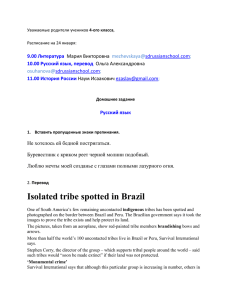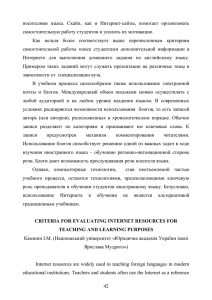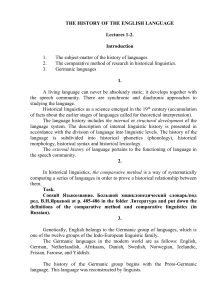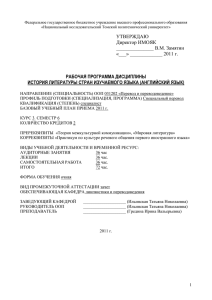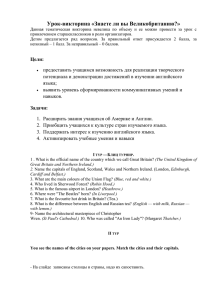Магистратура 031000
реклама
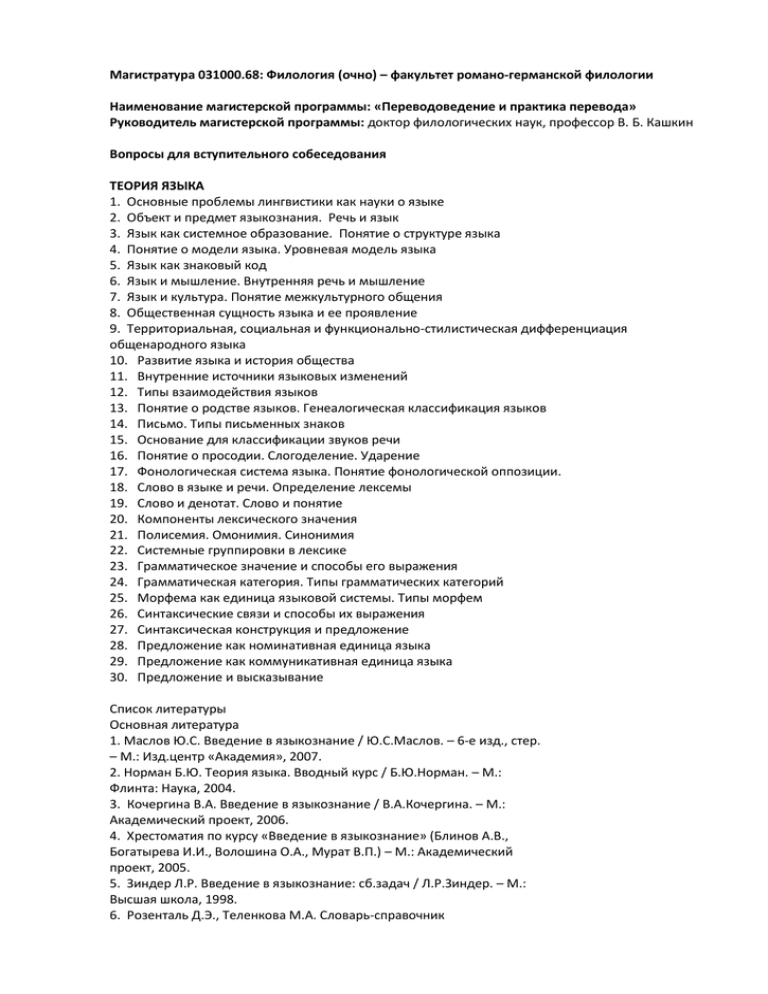
Магистратура 031000.68: Филология (очно) – факультет романо-германской филологии Наименование магистерской программы: «Переводоведение и практика перевода» Руководитель магистерской программы: доктор филологических наук, профессор В. Б. Кашкин Вопросы для вступительного собеседования ТЕОРИЯ ЯЗЫКА 1. Основные проблемы лингвистики как науки о языке 2. Объект и предмет языкознания. Речь и язык 3. Язык как системное образование. Понятие о структуре языка 4. Понятие о модели языка. Уровневая модель языка 5. Язык как знаковый код 6. Язык и мышление. Внутренняя речь и мышление 7. Язык и культура. Понятие межкультурного общения 8. Общественная сущность языка и ее проявление 9. Территориальная, социальная и функционально-стилистическая дифференциация общенародного языка 10. Развитие языка и история общества 11. Внутренние источники языковых изменений 12. Типы взаимодействия языков 13. Понятие о родстве языков. Генеалогическая классификация языков 14. Письмо. Типы письменных знаков 15. Основание для классификации звуков речи 16. Понятие о просодии. Слогоделение. Ударение 17. Фонологическая система языка. Понятие фонологической оппозиции. 18. Слово в языке и речи. Определение лексемы 19. Слово и денотат. Слово и понятие 20. Компоненты лексического значения 21. Полисемия. Омонимия. Синонимия 22. Системные группировки в лексике 23. Грамматическое значение и способы его выражения 24. Грамматическая категория. Типы грамматических категорий 25. Морфема как единица языковой системы. Типы морфем 26. Синтаксические связи и способы их выражения 27. Синтаксическая конструкция и предложение 28. Предложение как номинативная единица языка 29. Предложение как коммуникативная единица языка 30. Предложение и высказывание Список литературы Основная литература 1. Маслов Ю.С. Введение в языкознание / Ю.С.Маслов. – 6-е изд., стер. – М.: Изд.центр «Академия», 2007. 2. Норман Б.Ю. Теория языка. Вводный курс / Б.Ю.Норман. – М.: Флинта: Наука, 2004. 3. Кочергина В.А. Введение в языкознание / В.А.Кочергина. – М.: Академический проект, 2006. 4. Хрестоматия по курсу «Введение в языкознание» (Блинов А.В., Богатырева И.И., Волошина О.А., Мурат В.П.) – М.: Академический проект, 2005. 5. Зиндер Л.Р. Введение в языкознание: сб.задач / Л.Р.Зиндер. – М.: Высшая школа, 1998. 6. Розенталь Д.Э., Теленкова М.А. Словарь-справочник лингвистических терминов / Д.Э.Розенталь, М.А.Теленкова. – М., 1985. 7. Лингвистический энциклопедический словарь – М., 1990. Дополнительная литература 1. Норман Б.Ю. Игра на гранях языка / Б.Ю.Норман. – М.: Флинта: Наука, 2006. 2. Шелякин М.А. Язык и человек: к проблеме мотивированности языковой системы / М.А.Шелякин. – М.: Флинта: Наука, 2005. 3. С. Пинтер. Язык как инстинкт. Пер. с англ./ Общ.ред. В.Д. Мазо. – М.: Едиториал, 2004. ЗАРУБЕЖНАЯ ЛИТЕРАТУРА 1. Античная литература и мифология. 2. Литература Средневековья. 3. Литература Возрождения. 4. Литература XVII века: барокко и классицизм. 5. Литература XVIII века: просвещение, предромантизм. 6. Литература ХIХ века: романтизм, реализм. 7. Литература ХХ века: реализм, модернизм, постмодернизм. 8. Романтический гротеск в сказках Э.Т.А. Гофмана. 9. Трагический героизм в романе «Дон Кихот» М. Сервантеса. 10. О. Бальзак «Шагреневая кожа»: проблематика и поэтика. 11. Роман А. Камю «Посторонний»: особенности художественного отражения мира. 12. Английское общество в «Кентерберийских рассказах» Дж. Чосера. 13. Сатирико-аллегорическое изображение современной Англии в памфлете Дж.Свифта «Сказка бочки». 14. Трагический герой-титан в творчестве У. Шекспира («Гамлет», «Король Лир»). 15. Особенности художественного отражения мира в новеллистике Э. По. 16. Специфика психологизма и своеобразие героя в романе Ч. Диккенса «Домби и сын». 17. Психологическая проза Г. Джеймса (анализ произведения по выбору). 18. Дж. Джойс «Улисс». Техника «потока сознания». 19. Литература «потерянного поколения»: роман Э. Хемингуэя «Прощай, оружие!». 20. Проблемы современного общества в романе У. Голдинга «Повелитель мух». Список литературы Основная литература 1. Луков В. А. История литературы: Зарубежная литература от истоков до наших дней: Учебное пособие для студентов вузов / В.А. Луков. Междунар. акад. пед. образования .— М. : ACADEMIA, 2003.— 510,[1] с. — (Высшее образование) . 2. История зарубежной литературы Средних веков и эпохи Возрождения. Воронеж. гос. ун-т; сост. Е.А. Панкова, Т.В. Морозова.— Воронеж, 2004. 4. История зарубежной литературы XVII-XVIII вв.: учебно-методическое пособие .- Воронеж. гос. ун-т; сост. О.В. Тихонова .— Воронеж, 2004. <URL:http://www.lib.vsu.ru/elib/texts/method/vsu/dec04115.pdf> 5. История зарубежной литературы XVII века: Учебник для студ.вузов / Н.А.Жирмунская, З.И.Плавскин, М.В.Разумовская и др.; Под ред.М.В.Разумовской .— 2-е изд., испр. и доп. — М.: Высш.школа, 2000. 6. История зарубежной литературы XIX века: Учебник для вузов / Дмитриев А. С., Соловьева Н. А., Петрова Е. А. и др.; Под ред. Н. А. Соловьевой.— 2-е изд., испр. и доп. — М.: Высш. шк.: АCADEMIA, 2000. 7. Зарубежная литература XX века: Учебник для студ. вузов / Л.Г. Андреев, А.В. Карельский, Н.С. Павлова и др.; Под ред. Л.Г. Андреева.— 2-е изд.,испр. и доп. — М.: Высш. шк., 2003. 8. История Всемирной литературы в 9 т.т. – 1983. Дополнительная литература 9. Н.П.Михальская, Г.В.Аникин. История английской литературы: Учебник для гуманитарных факультетов вузов. – М.: Издательский центр «Академия», 1998. 10. Гиленсон Б.А. История литературы США: Учебное пособие для студ. высш.учеб. заведений – М.: Издательский центр, «Академия», 2003. 11. Дудова Л.В. Модернизм в зарубежной литературе: Литература Англии, Ирландии, Франции, Австрии, Германии: Учебное пособие по курсу "История зарубежной литературы XX в." специальности 201700 "Филология", 021800 "Лингвистика и межкультур. коммуникация" / Л.В.Дудова, Н.П. Михальская, В.П. Трыков .— 5-е изд. — М.: Флинта: Наука, 2004. АНГЛИЙСКИЙ ЯЗЫК Образцы тестов (уровень Certificate in Advanced English (CAE): Cambridge ESOL) ENGLISH IN USE 1. CLOZE VOCABULARY From the words listed below, choose the ones which best fit the space, A, B, C or D. PARROT RUSTLING Parrots and macaws have become so (01)......... that special varieties of these birds are (02) ......... up to ?9,000 each on the black market in Britain. Macaws from Brazil cost from ?1,000 and parrots from Australia can cost ?7,500 a pair. The demand for parrots, cockatoos and macaws has led to a (03)......... increase in thefts from zoos, wildlife parks and pet shops. London and Whipsnade zoos are among the many places from which parrots have been stolen. Some thefts have not been (04)......... in an effort to prevent further (05).......... . Parrot rustling, as it is known among bird fanciers, has increased rapidly in Britain since 1976 when imports and exports of (06)......... birds became (07)......... controlled. Quarantine controls, (08)......... with the scarcity of many types of parrots in the wild in Africa, Australia, Indonesia, and South America, have caused a shortage of birds which can be sold legally under (09).......... . This has sent prices to (10)......... levels. Working at night and equipped with wire-cutters, nets and substances to dope the birds, the rustlers are prepared to (11)......... serious risks to capture the parrots they want. At Birdworld, a specialist zoo, thieves (12)......... two parrots after picking their (13)......... through an enclosure containing cassowaries, The cassowary is a large flightless bird, related to the emu, which can be extremely (14)........., and has been (15)......... to kill humans with blows from its powerful legs. 01. A. costly B. extinct C. outlandish D. rare 02. A. raising B. reaching C. lifting D. fetching 03. A. acute B. peak C. sharp D. high 04. A. published B. publicised C. advertised D. told 05. A. happenings B. incidents C. acts D. activities 06. A. unusual B. uncommon C. exotic D. strange 07. A. tightly B. hardly C. toughly D. grimly 08. A. coupled B. doubled C. attached D. accompanied 09. A. warranty B. guarantee C. licence D. law 10. A. unknown B. unheard C. record D. highest 11. A. sustain B. assume C. take D. make 12. A. thieved B. robbed C. misappropriated D. stole 13. A. way B. road C. path D. lane 14. A. aggressive B. fighting C. bad-tempered D. rough 15. A. heard B. known C. considered D. able Check your answers: 01. D. rare 06. C. exotic 11. C. take 02. D. fetching 07. A. tightly 12. D. stole 03. C. sharp 08. A. coupled 13. A. way 04. B. publicised 09. C. licence 14. A. aggressive 05. B. incidents 10. C. record 15. B. known 2. CLOZE USAGE Complete with one word only in each space. HEALTH AND CIGARETTES In many Western countries, girls are more (01) ............. to smoke than boys. It's the girls who want to look "tough and grown-up." The result is that (02) ............. lung cancer in American men has fallen (03) ............. the first time in 50 years, the disease is (04) ............. in women. The decrease in the disease among men is attributed to a decrease in smoking among men (05) ............. the government's first warning of a (06) ............. between cigarettes and disease in 1964. On the other hand, lung cancer is now expected to overtake breast cancer (07) ............. the principal fatal cancer among women. (08) ............. your son or daughter is a non-smoker, there is another good (09)............. for rejecting a smoker as a life-long mate. Smokers don't just ruin their own health by (10) ............. up. They are a menace to (11) ............. . Second-hand smoke is lethal. As the 18th report on smoking by the United States Surgeon General (12) ............. it: "Involuntary smoking is a (13)............. of disease, including lung cancer, in healthy non-smokers." (14) ............. to the report, at home, the children of parents who smoke (15) ............. the effects in their respiratory systems. Smokers make their own kids sick. Check your answers: 01. likely, liable 07. as 12. puts 05. since, after 02. while, although 08. If 13. cause 03. for 09. reason 14. According 04. rising, increasing 10. lighting 15. show 06. link, connection 11. others 3. WORD FORMATION Complete with a word formed from those in the list. JOHN LENNON Lennon, if he is a symbol of anything, is a symbol of (01) .........., of play. He believed you could change the world. If you made the right gesture, a (02) .......... might take place. His life has become a myth, and high claims are made for him. He said that the Beatles were better known than Jesus Christ, which seemed to Christian (03) .......... a (04) .......... and (05) .......... thing to say, but he was probably right. The (06) .......... thing is that, by his violent death, he seems himself to have been elevated from musician, from supreme exponent of rock and roll, to the rank of prophet, shaman, myth. His wife, Yoko Ono, still serves as the (07) .......... of the myth, the keeper of the relics. She says: "He certainly wasn't a person who kowtowed or tried to preserve himself by shutting up. It's a very precious thing, I think, very (08).......... : this man who said it in a way for all of us. People identified with him because he said the truth, especially the truth they could not say." 01. CHILD ....................... 05. RESPONSIBLE ...................... 02. TRANSFORM ...................... 06. IRONY ...................... 03. CHURCH ...................... 07. MAID ...................... 04. SENSE ...................... 08. COURAGE ...................... Check your answers: 01. childhood 05. irresponsible 02. transformation 06. ironic, ironical 03. churchmen, church-goers 07. handmaiden 04. senseless 08. courageous 4. STRUCTURE AND MEANING Complete with the correct phrases from the list. THE CASE FOR VEGETARIANISM (01)........., the vets themselves are (02).........: (03)......... wished to remain anonymous. He said, "I hardly eat any meat these days, especially not in restaurants. In my opinion, it is not a wholesome product any more, (04)............. . I don't trust many of the producers or slaughterers I know. There is no effective (05).........." Thus, a meat inspector on an poultry line has three to five seconds to examine each bird and judge (06).......... . One vet (07)......... admitted that if a tumour is found it is cut out but the rest of the carcass is passed as (08).......... . (09)......... that the consumer is forcing change. Thus Gallup poll findings suggest that three million Britons now eat no red meat. In the past five years, three new anti-meat magazines (10).......... A involved in meat inspection I means of policing B have been launched J fit for human consumption C whether or not it is healthy K start up D speaking up L as far as meat is concerned E sometimes rather worried M moreover F plans for the future N one who reported G at least much of it isn't O it would seem H ready for eating Check your answers: 01. L. As far as meat is concerned 06. C. whether or not it is healthy 02. E. sometimes rather worried/ D. speaking up 07. A. involved in meat inspection 03. N. one reported 08. J. fit for human consumption 04. G. at least much of it isn’t 09. O. It would seem 05. I. means of policing 10. B. have been launched READING 1. ANGLO-INDIAN VOCABULARY Answer from the paragraphs A to I. Which "Indian" word(s) is more likely to be Portuguese than Indian in origin? 01 . ....................... refers to coloured cloth? 02. ........................ 03. ........................ is in origin more north-western European than Indian? 04. ........................ derive from the name of a place in India? 05. ........................ 06. ........................ refers to something which is not, strictly speaking, properly Indian? 07. .................... has been confused with a French equivalent? 08. ........................ came from Tamil? 09. ........................ 10. ........................ referred to a covering for the legs? 11. ........................ came into English from French? 12. ........................ became more precise in its meaning? 13. ........................ ANGLO-INDIAN ETYMOLOGY A. Gingham This is a kind of stuff, defined in the Draper's Dictionary as being made from cotton yarn dyed before being woven. The origin of this word is obscure, but it is likely that it originated in the Indian trade. Still, a Javanese dictionary gives ginggang, a sort of striped East Indian cotton. The verb ginggang in Javanese means "to separate, to go away" but this throws no light on the matter, nor can we connect the cloth with that of the name of a place on the northern coast of Sumatra. On the other hand, the Eastern derivation of the name has been entirely rejected. The right explanation is simply that gingham is an old English spelling of a town in Brittany, Guingamp, where linen was once manufactured. B. Bungalow The most usual class of house that was occupied by Europeans in the interior of India, being on one storey, and covered by a pyramidal roof, which in the normal bungalow is of thatch, but may be of tiles without impairing its title to be called a bungalow. In reference to the style of house, bungalow is sometimes used in contradistinction to the (usually more pretentious) pucka house; by which latter term is implied a masonry house with a terraced roof. A bungalow may be a small building of the type which we have described, but of temporary material, in a garden. The term has been adopted by Europeans generally in Ceylon and China. The word derives from bangla, which is probably from the place Banga in Bengal. It is to be remembered that in Hindustan proper the adjective, of or belonging to Bengal, is constantly pronounced as bangala or bangla. The probability is that when Europeans started to build houses of this character in Behar and Upper India, these were called Bangla or "Bengal-fashion" houses. C. Calico This cotton cloth, of a reasonably fine texture, occurs in the 17th century in the form calicut. The word may have come into English through the French calicot, which in turn comes from Calicut, which in the Middle Ages was the chief city and one of the ports of Malabar. The fine cotton material of the Malabar coast was mentioned by Marco Polo. The cotton itself seems to have been brought from the hinterland as Malabar cotton, ripening during the rains, is not usable. D. Pyjamas This word derives from the Hindi pae-jama, literally translated as "leg-clothing", a pair of loose drawers, tied round the waist. Such a garment was worn by Sikh men and by Moslems of both sexes. It was adopted by Europeans as comfortable casual clothing and as night attire. It is probable that the clothing and the word came into English usage from the Portuguese. Originally, pyjamas sometimes had feet sewn into them and when a Jermyn St tailor was asked why, he replied, "I believe, sir, it is because of the white ants." And as a traveller remarked in 1881, "The rest of our attire consisted of that particularly light and airy white flannel garment, known throughout India as a pyjama suit." E. Chintz This, a printed or spotted cotton cloth, is called chint in Hindi, but appears to stem from the Sanskrit, chitra, meaning variegated or speckled. The French form of the word is chite, which has suggested the English sheet being of the same origin. But chite is apparently of Indian origin, whilst sheet is much older than the Portuguese communication with India. The manufacture and export of chintzes from India to Europe has now ceased. However, in Java and Sumatra, chintzes of a very peculiar kind of marbled pattern are still manufactured under the name of batik. F. Veranda This, referring to an open pillared gallery round a house, is one of the very perplexing words for which at least two origins may be maintained, both with equal plausibility. One group consider it to be of Sanskrit origin, barandah, meaning a portico. However, others point out that verandah with the meaning in question does not belong to the older Sanskrit, but is found only in comparatively modern works. That the word as used in England and France was brought by the English from India need not be doubted. But either in the same sense, or in one closely analogous, it seems to have existed quite independently in both Spanish and Portuguese. The suspicion must be that the word was taken to India by the Portuguese and thence re-exported by the English to northern Europe. G. Cheroot This is a cigar, but the term has been appropriated especially to cigars truncated at both ends, as Indian cigars always were in the old days. The word is Tamil, shuruttu, translated as a roll of tobacco. In the south, cheroots were chiefly made at Trichinopoly and were consequently known as Trichies. Grose, in around 1760, speaking of Bombay, whilst describing the cheroot does not use that word, but another, buncus, which is now entirely obsolete. H. Thug The word is found in Sanskrit and in Hindi where it means a cheat and a swindler, but during the 19th century is acquired a more specific meaning, referring to robbers of a particular type who formed a gang and pretended to be travellers, perhaps on business or on a pilgrimage. They would join other travellers on the road, befriend them and then, given a suitable opportunity, would strangle them, plunder them and bury their bodies. The proper name for such people was phansigar, from the word phansi, meaning "a noose", because they would throw a slip-knot around the necks of their victims. I. Curry Curry consists of meat, fish, fruit or vegetables, cooked with a quantity of bruised spices and turmeric. A little of this gives flavour to a large mess of rice. The word is Tamil in origin, kari, meaning "sauce". It is possible, however, that the kind of curry found in restaurants is not of purely Indian origin, but has come down to us from the spiced cookery of medieval Europe and Western Asia. There is, indeed, no room for doubt that the capsicum or red pepper was introduced into India by the Portuguese. The Sanskrit books of cookery, which cannot be of any considerable antiquity, contain many recipes for curry without this ingredient. [definitions from Hobson-Jobson] Check your answers: 01. F 05/06. B, C 09/10. G, I 02/03. A, E 07. I 11. D 04. A 08. E 12. C 13. H 2. COMPREHENSION MULTIPLE CHOICE Read the passage and answer the questions which follow. PRIVATE SCHOOLS Most countries have had, and some still have, educational systems that are, in one way or another, social disasters. The English educational system is unique, however, in the degree to which it has created educational institutions which perpetuate privilege and social division. Most countries have some private schools for the children of the wealthy; the English have dozens of them. In fact, about 3,000. Some nine million children are educated at state schools; just under half a million are educated at private schools. What is the result of such a system? The facts seem to speak for themselves. In the state system, about eight per cent make it to university; in the private system, almost half the students go on to university. But those statistics are deceptive: middle class children do better at examinations than working class, and most of them stay on at school after 16. Private schools are entirely middle class, and so this positive attitude creates an environment of success. Private schools are enormously expensive, as much as ?18,000 a year for a boarder at somewhere like Eton or Harrow to at least ?8,000 a year almost everywhere. Why are parents, many of whom are not wealthy or even comfortably off, willing to sacrifice so much in the cause of their children's schooling? One father replied to this question by saying: "Everything is on the margin. If my son gets a five per cent better chance of going to university, that may be the difference between success and failure." You can believe him if you like, but ?50,000 minimum is a lot to pay for a five per cent better chance. Most children, given the choice, would take the money. The real reason parents fork out the cash is prejudice: they don't want little Henry mixing with the workers, or getting his accent wrong. And anyway, at your next dinner party it won't sound too good if all the guests are sending their kids to St Swotting-by-theSea, and you say your kid is going to the state school down the road even if, as a result, you are able to serve Chateau Margaux with the filet steak. Of course, at many of the best private schools, your money buys you something. One school, with 500 pupils, has 11 science laboratories; another, with 800, has 30 music practice rooms; another has 16 squash courts, and yet another has its own beach. On investment in buildings and facilities, the private schools spend ?300 per pupil; the state system spends less than ?50. On books, the ratio is ?150 to ?50. One of the things that your money buys which is difficult to quantify is the appearance of the school, the way it looks. Most private schools are established in beautiful, well-kept country houses, with extensive grounds and gardens. They look good in contrast with the state schools, the worst of which, like public lavatories, are tiled or covered in graffiti, and the best of which have architectural design on the level of an industrial shed. Leaving aside the question of money, the attitudes generally to be found in the private schools are repellent. In a book published in 1988, some former Etonians were invited to talk about themselves and their old school. One of them said: "At school you could point out the freaks very easily. Freaks were spotty or ugly, freaks were scholars, basically people who had too many brains, and were looked down upon because they didn't pay." Yet another talked of the hunger marchers of the thirties who came through Windsor like "some sort of cloth-capped cavalcade", and went on "one was more aware of George V dying, because you were part of the same village." Another said that saving up to send a son to Eton was "the wrong thing... you're bred in terms of privilege and education to be a racehorse, and you end up having to toil in some office block somewhere in the City..., it's a waste of an expensive training. You don't go and run a donkey in the Derby, do you?" One old Etonian tells how he was received by the printers when he went to work on a provincial newspaper. Printers were well-known as belonging to the most left-wing of all unions, and yet: "They loved me, they adored me... because I was nice and jolly with them, I was little Lord Fauntleroy, and they used to say, `Isn't it marvellous, he was at Eton and he still talks to us, and he jokes and laughs and he's really quite a nice guy.'" Some, perhaps many, private school pupils find life there unpleasant in the extreme. Such a one was Graham Greene. Yet he still sent his own son to the same school. In another case, an Old Etonian admitted the school was "a ghastly hideous place, it was a nightmare" and yet he too wishes the school upon his son: "I found it was a reflex that, as soon as Alexander was born, within three weeks I went and registered him." Rather, when one thinks about it, as one might register a pedigree dog with the Kennel Club. One has to ask the question if such privileges and attitudes are relevant to a country in which there is almost as great a chance of an individual attending psychiatric hospital as of going to university. 01. The English educational system is different from any other because A. has a balance between state and private education B. has more private schools than anywhere else C. contributes to creating a class system D. has so many things wrong with it 02. More private school children go to university because A. they are better taught B. their parents are middle class C. the schools create success D. they stay at school longer 03. Parents most often send their children to private school A. for social reasons B. for a margin of success C. to show how much money they have D. to pass university entrance examinations 04. Children at private schools A. work very hard all the time B. are conformist and prejudiced C. are very clever and highly educated D. are well-bred and cultivated 05. Former students of private schools A. automatically send their children there B. are inclined to think it is not worth the money C. are worried that they might end up in psychiatric hospital D. think carefully and then enrol their child in the best school Check your answers 01. C 02. B 03. A 04. B 05. A Для подготовки к тесту по английскому языку можно использовать электронные ресурсы: http://www.englishspeaker.com/index%20-%20CAE.html http://www.languageproject.co.uk/free_exercises/cae.php http://www.examenglish.com/CAE/?gclid=CPvlh6eQuJsCFc4TzAodTU19CA http://www.examenglish.com/CAE/English_in_Use.php http://www.englishforjapanese.com/tests/Cambridge/cae/reading/01%20scan%20detail.html
